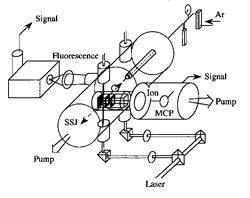Vol.
25 No. 5
September-October 2003
Critical
Assessment: Use of Supersonic Jet Spectrometry for Complex
Mixture Analysis (IUPAC Technical Report)
T.
Imasaka, D. S. Moore, and T. Vo-Dinh
Pure
and Applied Chemistry
Vol. 75, No.7, pp. 975-991 (2003)
 |
A
typical analytical instrument for supersonic jet spectrometry,
which allows detection by fluorescence excitation /emission
and multiphoton ionization/mass spectrometries simultaneously.
Source: T. Imasaka, M. Hozumi, N. Ishibashi. Anal. Chem.
64, 2206 (1992). (Larger
view)
|
Numerous
chemical substances are present in an authentic sample. Therefore,
it is necessary to develop an analytical instrument with high
selectivity. However, absorption or excitation/fluorescence
spectrometry currently used for analysis of the sample in
the condensed phase at room temperature provides a broad band
in the spectrum. Therefore, it is difficult to apply it to
complex mixture analysis.
When
the analyte molecule is cooled to a temperature of a few K
using supersonic jet expansion into a vacuum, a molecule exists
in the lowest vibrational level of the ground electronic state
and is isolated at collision-free conditions. The absorption
or excitation/ fluorescence spectrum is then greatly simplified
when transitions occur from this single vibrational level
to a limited number of vibrational levels in the excited electronic
state. This method, called supersonic jet spectrometry, is
a powerful analytical technique because of its high selectivity,
since the chemical species can be accurately identified and
selectively quantified using the sharp spectral features even
for large molecules.
Supersonic
jet spectrometry has distinct advantages over other low-temperature
spectrometries, in that it can be combined with gas phase
separation and detection techniques such as chromatography
or mass spectrometry. Therefore, this spectrometric technique
can be used as a versatile analytical means, not only for
basic research on single standard molecules but also for practical
trace analysis of chemical species in multicomponent samples
(e.g., in biological monitoring or in environmental monitoring).
In
this critical assessment basic operational principles and
analytical instrumentation are introduced in addition to various
applications to polycyclic aromatic hydrocarbons, polymer
decomposition products, and chemically hazardous compounds
such as dioxins. Several approaches for assignment of the
chemical species are also provided, which involve the use
of the data of the 0-0 transition for ca. 300 organic compounds
and of the theoretical techniques using molecular orbital
calculation and fuzzy recognition of the spectral feature.
www.iupac.org/publications/
pac/2003/7507/7507x0975.html
Page
last modified 29 August 2003.
Copyright © 2002-2003 International Union of Pure and
Applied Chemistry.
Questions regarding the website, please contact [email protected]
|